Map Snapshot
























1,866 Records
Status
Common Five-lined Skink (Plestiodon fasciatus) is the most familiar Plestiodon in Maryland, and it is distributed statewide in suitable habitat, but more commonly in the coastal plain. It generally favors relatively humid woodland habitats, especially in rocky areas, or near logs or tree stumps, rotting wood, or sawdust piles. This species is much more terrestrial than its relative, the Broad-headed Skink (Conant & Collins, 1998; Maryland DNR site).
Description
Although there are several useful marks for distinguishing Common Five-lined Skink from the larger Broad-headed Skink, the most reliable method involves counting facial scales. Close-up head shots can sometimes be used to ID confidently to species. Common Five-lined show four labial scales anterior to the subocular scale on the face, and two postlabial scales in front of the ear canal. Broad-headed shows five labials, and no large postlabial scales (Conant & Collins, 1998).
Seasonality Snapshot
Source: Wikipedia
| Plestiodon fasciatus | |
|---|---|

| |
| Adult male | |

| |
| Juvenile | |
| Scientific classification | |
| Domain: | Eukaryota |
| Kingdom: | Animalia |
| Phylum: | Chordata |
| Class: | Reptilia |
| Order: | Squamata |
| Family: | Scincidae |
| Genus: | Plestiodon |
| Species: | P. fasciatus
|
| Binomial name | |
| Plestiodon fasciatus | |

| |
| Synonyms | |
| |


The (American) five-lined skink (Plestiodon fasciatus) is a species of lizard in the family Scincidae. The species is endemic to North America. It is one of the most common lizards in the eastern U.S. and one of the seven native species of lizards in Canada.
Common names
[edit]Other common names for P. fasciatus include blue-tailed skink (for juveniles) and red-headed skink (for adults). It is technically appropriate to call it the American five-lined skink to distinguish it from the African skink Trachylepis quinquetaeniata (otherwise known as five-lined mabuya) or the eastern red-headed skink to distinguish it from its western relative Plestiodon skiltonianus (otherwise known as the western skink). The blue-tailed skink proper is Cryptoblepharus egeriae from Christmas Island, but in North America the juveniles of any Eumeces or Plestiodon species may be called this.
Description
[edit]The American five-lined skink is small to medium-sized, growing to about 12.5 to 21.5 centimetres (4.9 to 8.5 in) total length (including tail). Young American five-lined skinks are dark brown to black with five distinctive white to yellowish stripes running along the body and a bright blue tail. The blue color fades to light blue with age, and the stripes also may slowly disappear. Females however, are more likely to retain the blue tail color as they age.[5] The dark brown color fades, too, and older individuals are often uniformly brownish. The southeastern five-lined skink, P. inexpectatus, of the Southeastern United States is very similar to this species and there is some overlap in range. The two species can be distinguished by their scales.[6] The broad-headed skink, P. laticeps, is similar, and may be difficult to distinguish from P. fasciatus. The former species usually lacks the two enlarged postlabial scales characteristic of P. fasciatus.[7][8] Adult male broad-headed skinks, with their large size and swollen red head, are readily distinguished from P. fasciatus.[9] Research suggests that are sexually dimorphic in terms of size. The males are often larger than the females, but this depends on the area they live.[10] Their claws are short and curved downward; they make a right angle at the axis of each toe.[11]
Geographic range
[edit]
The range of the American five-lined skink extends in the north to southern Ontario, Michigan and eastern New York. The western border is in Minnesota, Missouri and eastern Kansas, Nebraska, Oklahoma, Florida, Mississippi, Louisiana, Tennessee and Texas. P. fasciatus tends to be most abundant on the coastal plain in the southeastern United States and along the Gulf Coast. It has now been seen in increasing numbers in the northern Chesapeake Bay Region of Maryland particularly along the shores of the Elk River, and northern Virginia.It has also been seen in northern South America, such as Colombia.[citation needed]
Habitat
[edit]The American five-lined skink is a ground-dwelling animal. It prefers moist, hardwood areas with a permanent water source such as rivers or streams, as well as sites to bask in the sun.[12] It can also be found in broken, rocky areas at the northern edge of its habitat. Within the northern edge of its habitat, it was found that they prefer areas with longer than average rock cover in areas with few trees.[13] While little is known about any hibernation patterns, P. fasciatus is rarely seen throughout winter and the surrounding months. It is assumed by scientists that they are sheltered and dormant under rocks, logs, or leaves provided by the hardwood areas it inhabits.[14] They are resistant to minor disturbances, but can be affected by the removal of woody debris in their northern habitats.[15]
Reproduction
[edit]Fertilization in the American five-lined skink is internal, with eggs laid by the female between the middle of May and July, at least one month after mating. Males will mate with multiple females. The mating season begins in May. The female Plestiodon will lay its eggs in June, and four to six weeks after the incubation, the young hatch. Thus the birthing process consists of laying eggs and external incubation.[16] Fertilization occur shortly after copulation, unlike many other lizard species Plestiodon fasciatus females are unable to store sperm between successive clutches.[17] One study found that most clutches had multiple sires, but within those clutches, there was unequal sharing of paternity.[18]
Females lay fifteen to eighteen eggs in a small cavity cleared beneath a rotting log, stump, board, loose bark, a rock, or an abandoned rodent burrow.[19] Females prefer secluded nest sites in large, moderately decayed logs. Soil moisture is also an important factor in nest selection. Females often place nests in regions where soil moisture is higher than in adjacent areas. Vertical position of the nest also varies with moisture, with nests located deeper in a soil cavity at dry sites. Even when nesting sites are not limited, a significant amount of aggregation occurs.
The parchment-like eggs of the American five-lined skink, similar to many other reptiles, are thin and easily punctured. Freshly laid eggs range from spherical to oval in shape averaging 1.3 cm (0.51 in) in length. Absorption of water from the soil leads to increased egg size. Egg coloration also changes over time, from white to mottled tan, after contact with the nest burrow. The incubation period ranges from 24 to 55 days, and varies due to fluctuations in temperature. Females typically brood their eggs during this time, exhibiting defensive behavior against smaller predators. Parental care ends a day or two after hatching when hatchlings leave the nest. Young American five-lined skinks, with a potential life span of up to six years, attain sexual maturity and begin reproducing within two to three years of hatching.[20]
Behavior
[edit]
Adult male American five-lined skinks exhibit complex courtship and aggressive behavior. Although males tolerate juveniles and females in their territories, they actively defend these areas against other males. It has been proposed that one of the functions of their blue tails is intraspecific communication with the purpose of preventing attacks by more aggressive males because the blue tail signifies that they are juveniles or females.[21] Vomeronasal analysis of chemical cues and recognition of sex-specific visual stimuli, including tail and body coloration, aid in the identification of sex. Evidence suggests that males may rely more on contact pheromones than volatile airborne molecules in the identification of conspecifics. Courting males grasp the necks of receptive females in their jaws after approaching them from the side. Using the tail to align cloacal openings, males initiate copulation by inserting one of the two hemipenes into the female's cloaca. Copulation events typically last four to eight minutes.
Female American five-lined skinks demonstrate high levels of parental care which reduces egg mortality. Females exhibit several brooding positions of variant contact levels with the body placed beside, over, through, or in a coil around the eggs. Brooding position varies according to soil moisture. Maternal body contact increases at lower moisture levels potentially reducing the transpirational loss of the eggs. In communal nests, females may alternate foraging and guarding of the nests, leaving eggs protected at all times. Females may also urinate in the nests and turn eggs to maintain humidity. In addition, females transfer heat from basking through body contact. Any eggs displaced from the nest are retrieved by head or snout rolling, and rotten eggs are eaten.
American five-lined skinks also exhibit antipredation behavior. In evasion of various predators including snakes, crows, hawks, shrews, moles, opossums, skunks, raccoons, and domestic cats, skinks may disconnect their entire tail or a small segment. It is thought that the bright blue color attracts predators to the expendable tail.[22] Skinks run to shelter to escape their death as the disconnected tail continues to twitch. Skinks may also utilize biting as a defensive strategy.[20]
Diet
[edit]The common five-lined skink's diet consists primarily of a variety of arthropods, particularly spiders, crickets, beetles and other insects. However, they have been reported to also eat newborn mice, frogs, and other lizards. Wild skinks will make short forays into heavily used core areas to find food.[23] Those who own a pet skink are advised to supplement the skink's diet with fruits and vegetables. In addition to eating insects, skinks enjoy a variety of fruits and vegetables. Fruits that skinks enjoy include blueberries, mangos, raspberries, papayas, cantaloupes, strawberries, and figs.[24] Studies have indicated that the majority of the five-lined skink's diet is mostly invertebrates, which for some of the many prey species the effect is negligible, but because of its voracious diet, its predation may be a major ecological factor.[25]
Conservation status
[edit]The Great Lakes - St. Lawrence population of P. fasciatus is listed as "special concern" in Ontario and Canada by COSSARO[26] and COSEWIC.[27] It is illegal to remove any of the three species of skinks found in Canada from their habitats. Skinks are at the extreme edge of their habitat range in Canada, which makes it an area of special interest to ecologists, as extreme conditions place unique evolutionary pressures upon species. The American five-lined skink has split into two phylogenetically-distinct populations in this edge habitat; the Carolinian population, also present in the United States, ends around Point Pelee National Park in southern Ontario. The Carolinian population is listed as "endangered" in Ontario and Canada by COSSARO,[26] COSEWIC,[27] The St. Lawrence / Great Lakes population resides in the Ottawa Valley in eastern Ontario and tends to be more tolerant to sparse or rocky conditions than its sister subspecies.[28]
Captive care
[edit]American five-lined skinks can be maintained in captivity with minimal care.[citation needed] Some U.S. states impose general restrictions on taking reptiles including native American five-lined skinks from the wild without a permit or hunting license, for example Maryland (no more than 4 may be possessed without a permit),[29] Indiana[30] and Ohio.[31]
A pair of skinks may live in a 25-30 US gallon terrarium, and may live for 5–10 years with adequate care.[32][33]
Photo gallery
[edit]-
Clutch of eggs hatching
-
Part of the tail regrowing
-
Female or sub-adult male, dorsal view
-
View of the tail
-
Juvenile with a still vivid blue tail
-
Juvenile on the side of a man-made structure
References
[edit]- ^ Hammerson, G.A. (2007). "Plestiodon fasciatus". IUCN Red List of Threatened Species. 2007: e.T64227A12756007. doi:10.2305/IUCN.UK.2007.RLTS.T64227A12756007.en. Retrieved 6 September 2018.
- ^ a b c d e Species Plestiodon fasciatus at The Reptile Database . www.reptile-database.org
- ^ a b Stejneger, L., and T. Barbour (1917). A Check List of North American Amphibians and Reptiles. Cambridge, Massachusetts: Harvard University Press. 125 pp. (Plestiodon fasciatus, p. 69).
- ^ Boulenger, G.A. (1887). Catalogue of the Lizards in the British Museum (Natural History). Second Edition. Volume III. Lacertidæ, Gerrhosauridæ, Scincidæ ... London: Trustees of the British Museum (Natural History). (Taylor and Francis, printers). xii + 575 pp. + Plates I-XL. (Eumeces quinquelineatus, pp. 369-370).
- ^ Fitch, Henry S. (2019-12-13). Life History and Ecology of the Five-Lined Skink, Eumeces fasciatus. Good Press.
- ^ Breen, John F. (1992). Encyclopedia of Reptiles and Amphibians. Hong Kong: T.F.H. Publications.
- ^ Palmer, William M., Alvin L. Braswell, Renaldo Kuhler (1995). Reptiles of North Carolina. Chapel Hill: University of North Carolina Press. ISBN 0-8078-2158-6.
- ^ Palmer, William M.; Braswell, Alvin L.; Kuhler, Renaldo (1995). Reptiles of North Carolina. Chapel Hill: University of North Carolina Press. ISBN 0-8078-2158-6.
- ^ Beane, Jeff (2006). "Love Skinks". Wildlife in North Carolina 70: 14-19. ISSN 0043-549X.
- ^ Howes, Briar J.; Lougheed, Stephen C. (May 2007). "Male body size varies with latitude in a temperate lizard". Canadian Journal of Zoology. 85 (5): 626–633. doi:10.1139/Z07-043. ISSN 0008-4301.
- ^ Brungs, William A.; Britt, N. Wilson (1960-12-30). "An Albino Five-Lined Skink, Eumeces fasciatus Linnaeus". Copeia. 1960 (4): 369. doi:10.2307/1439781. ISSN 0045-8511. JSTOR 1439781.
- ^ Beane, Jeff (2018). Life History and Ecology of the Five-Lined Skink.
- ^ Quirt, Kate C.; Blouin-Demers, Gabriel; Howes, Briar J.; Lougheed, Stephen C. (2006). "Microhabitat Selection of Five-Lined Skinks in Northern Peripheral Populations". Journal of Herpetology. 40 (3): 335–342. doi:10.1670/0022-1511(2006)40[335:MSOFSI]2.0.CO;2. ISSN 0022-1511. JSTOR 4093002.
- ^ Finch, Henry (2019). Life History and Ecology of the Five-Lined Skink.
- ^ Hecnar, S. J.; M.'Closkey, R. T. (1998-09-01). "Effects of human disturbance on five-lined skink, Eumeces fasciatus, abundance and distribution". Biological Conservation. 85 (3): 213–222. doi:10.1016/S0006-3207(98)00014-7. ISSN 0006-3207.
- ^ "Common five-lined skink - Plestiodon fasciatus ". Virginia Herpetological Society. Retrieved 2 August 2015
- ^ Bateson, Zachary W.; Krenz, John D.; Sorensen, Robert E. (December 2011). "Multiple Paternity in the Common Five-lined Skink (Plestiodon fasciatus)". Journal of Herpetology. 45 (4): 504–510. doi:10.1670/10-295.1. ISSN 0022-1511. S2CID 86218116.
- ^ Bateson, Zachary W.; Krenz, John D.; Sorensen, Robert E. (December 2011). "Multiple Paternity in the Common Five-lined Skink (Plestiodon fasciatus)". Journal of Herpetology. 45 (4): 504–510. doi:10.1670/10-295.1. ISSN 0022-1511. S2CID 86218116.
- ^ Harding, J. (1997). Amphibians and Reptiles of the Great Lakes Region. Ann Arbor, Michigan: University of Michigan Press.
- ^ a b "Plestiodon fasciatus (Five-lined Skink)". Animal Diversity Web. Retrieved 19 May 2017.
- ^ Clark, Donald R.; Hall, Russell J. (1970). "Function of the Blue Tail-Coloration of the Five-Lined Skink (Eumeces fasciatus)". Herpetologica. 26 (2): 271–274. ISSN 0018-0831. JSTOR 3890750.
- ^ Clark, D. R., & Hall, R. J. (1970). Function of the Blue Tail-Coloration of the Five-Lined Skink (Eumeces fasciatus). Herpetologica, 26(2), 271–274.
- ^ Hecnar, S. J., & M.’Closkey, R. T. (1998). Effects of human disturbance on five-lined skink, Eumeces fasciatus, abundance and distribution. Biological Conservation, 85(3), 213–222. https://doi.org/10.1016/S0006-3207(98)00014-7
- ^ "Common Five-lined Skink | State of Tennessee, Wildlife Resources Agency". www.tn.gov. Retrieved 2019-03-12.
- ^ Fitch, Henry S. (2019). Life History and Ecology of the Five-Lined Skink, Eumeces fasciatus. Good Press. p. 3.
- ^ a b "Species at risk in Ontario". 16 July 2014. Retrieved 19 May 2017.
- ^ a b Canada, Government of Canada, Environment (27 April 2011). "Species Profile (Five-lined Skink) - Species at Risk Public Registry". www.sararegistry.gc.ca. Retrieved 19 May 2017.
{{cite web}}: CS1 maint: multiple names: authors list (link) - ^ Quirt, Kate C.; Blouin-Demers, Gabriel; Howes, Briar J.; Lougheed, Stephen C. (2006). "Microhabitat Selection of Five-lined Skinks in Northern Peripheral Populations". Journal of Herpetology. 40 (3): 335–342. doi:10.1670/0022-1511(2006)40[335:MSOFSI]2.0.CO;2. S2CID 85677729.
- ^ "Captive Reptile & Amphibian Permit/License". Maryland Department of Natural Resources.
- ^ "Indiana's Reptile and Amphibian Regulations". Indiana Department of Natural Resources. 29 January 2021.
- ^ "Specialty Licenses & Permits". Ohio Department of Natural Resources.
- ^ "skinks - Care Sheets Information about Five lined skink". Repticzone. Retrieved 2016-03-12.
- ^ "Caudata.org Newt and Salamander Forum". www.caudata.org. Retrieved 2016-03-12.
- ^ Georgia wildlife
- ^ Palmer, Braswell & Kuhler 1995
Further reading
[edit]- Behler, J.L., and F.W. King (1979). The Audubon Society Field Guide to North American Reptiles and Amphibians. New York: Alfred A. Knopf. 743 pp. ISBN 0-394-50824-6. (Eumeces fasciatus, pp. 570–571 + Plates 427, 437, 443).
- Conant, R. (1975). A Field Guide to Reptiles and Amphibians of Eastern and Central North America, Second Edition. Boston: Houghton Mifflin. xviii + 429 pp. + Plates 1-48. ISBN 0-395-19979-4 (hardcover), ISBN 0-395-19977-8 (paperback). (Eumeces fasciatus, pp. 122–123, Figure 26 + Plate 19 + Map 75).
- Linnaeus, C. (1758). Systema naturæ per regna tria naturæ, secundum classes, ordines, genera, species, cum characteribus, differentiis, synonymis, locis. Tomus I. Editio Decima, Reformata. Stockholm: L. Salvius. 824 pp. (Lacerta fasciatus, new species, p. 209). (in Latin).
- Martof, Bernard S., et al. (1980). Amphibians and Reptiles of the Carolinas and Virginia. Chapel Hill: University of North Carolina Press. ISBN 0-8078-4252-4.
- Powell, R., R. Conant and J.T. Collins (2016). Peterson Field Guide to Reptiles and Amphibians of Eastern and Central North America, Fourth Edition. Boston and New York: Houghton Mifflin Harcourt. xiv + 494 pp., 47 plates, 207 figures. ISBN 978-0-544-12997-9. (Plestiodon fasciatus, pp. 307–308 + Plate 29 + Figures 113, 147, 148 + photo on p. 493).
- Smith, H.M., and E.D. Brodie, Jr. (1982). Reptiles of North America: A Guide to Field Identification. New York: Golden Press. 240 pp. ISBN 0-307-13666-3. (Eumeces fasciatus, pp. 76–77).
- Jensen, John B., Carlos D. Camp, Whit Gibbons and Matt J. Elliott (editors) (2008). Amphibians and Reptiles of Georgia. Athens, Georgia: University of Georgia Press. 579 pp. (Five-lined Skink, p. 308). ISBN 0820331112.
External links
[edit]- Five-lined Skink, Canadian Biodiversity.
- Five-lined Skink, Reptiles and Amphibians of Iowa.
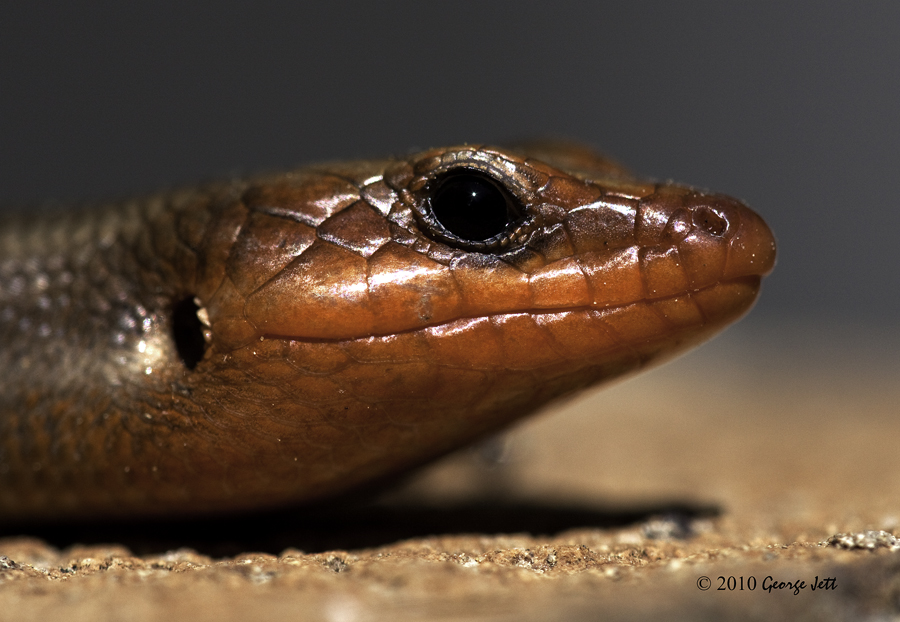
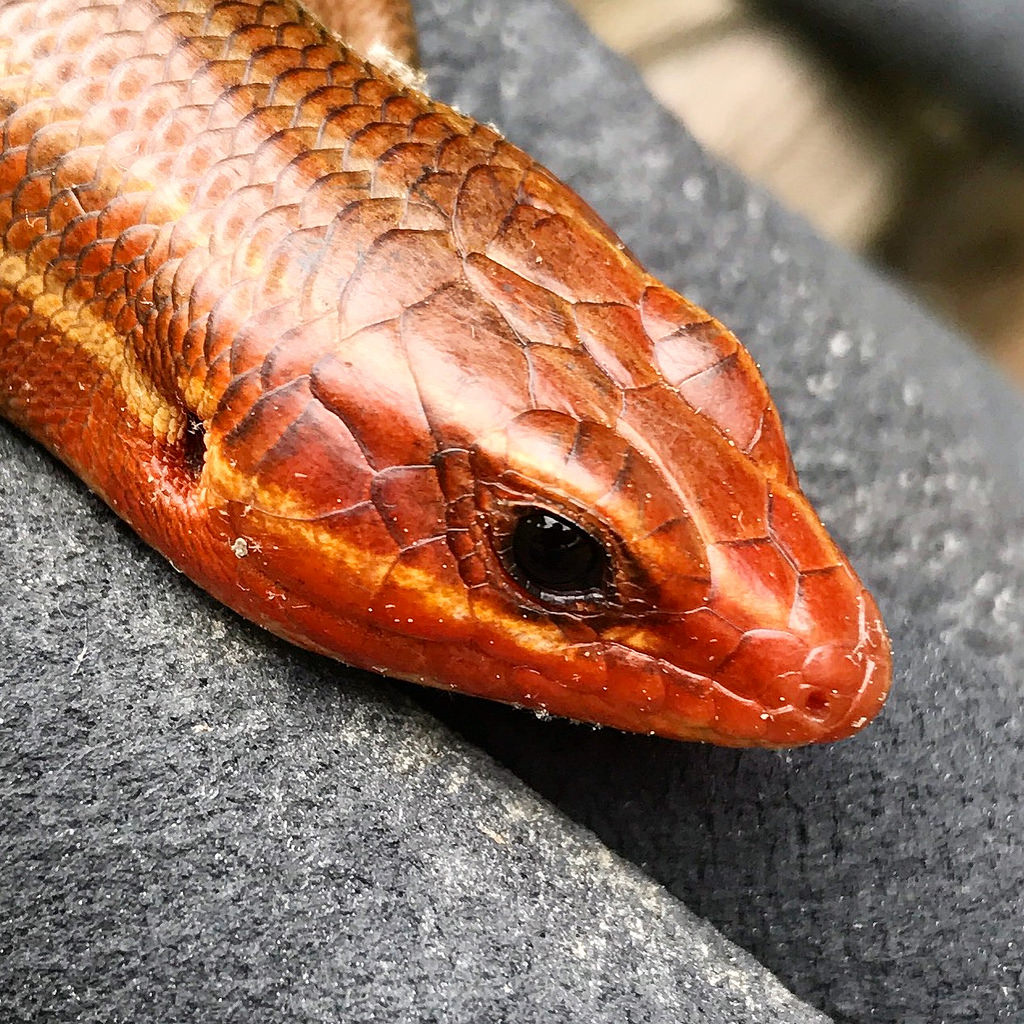
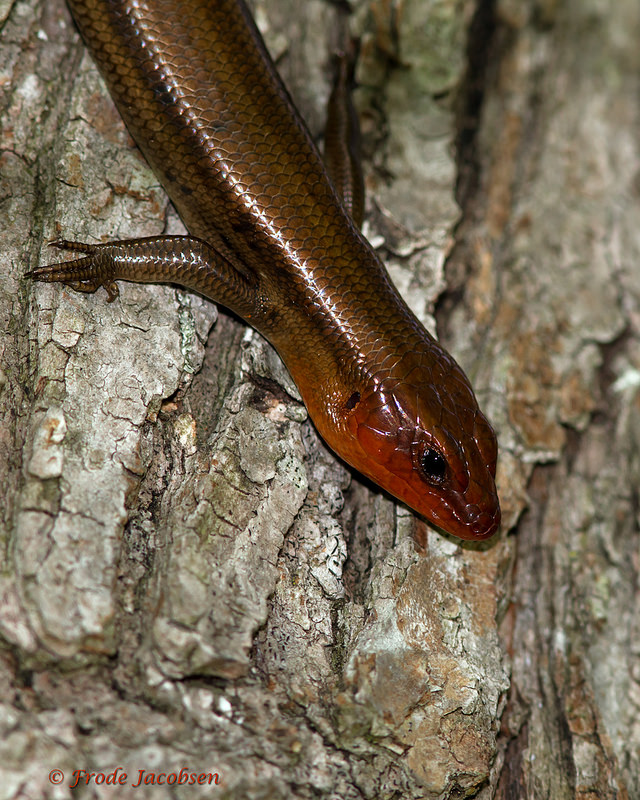
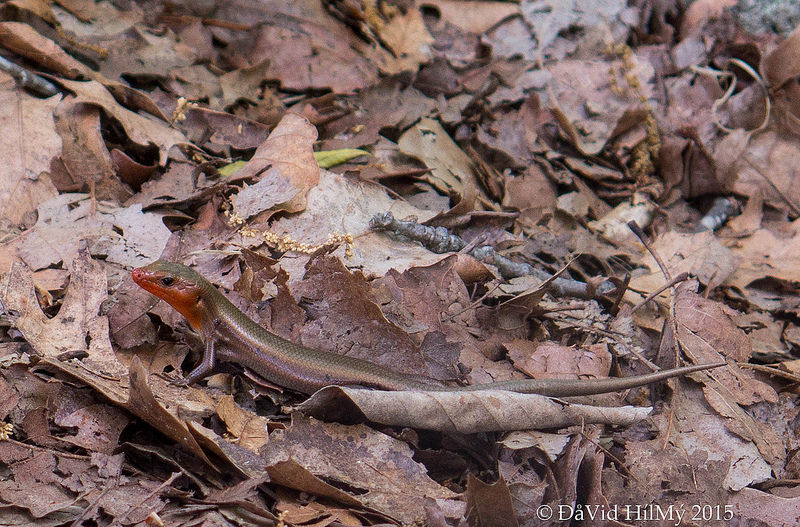
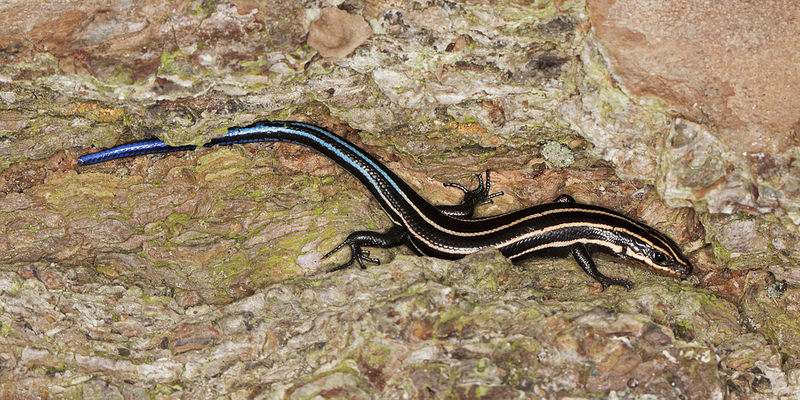
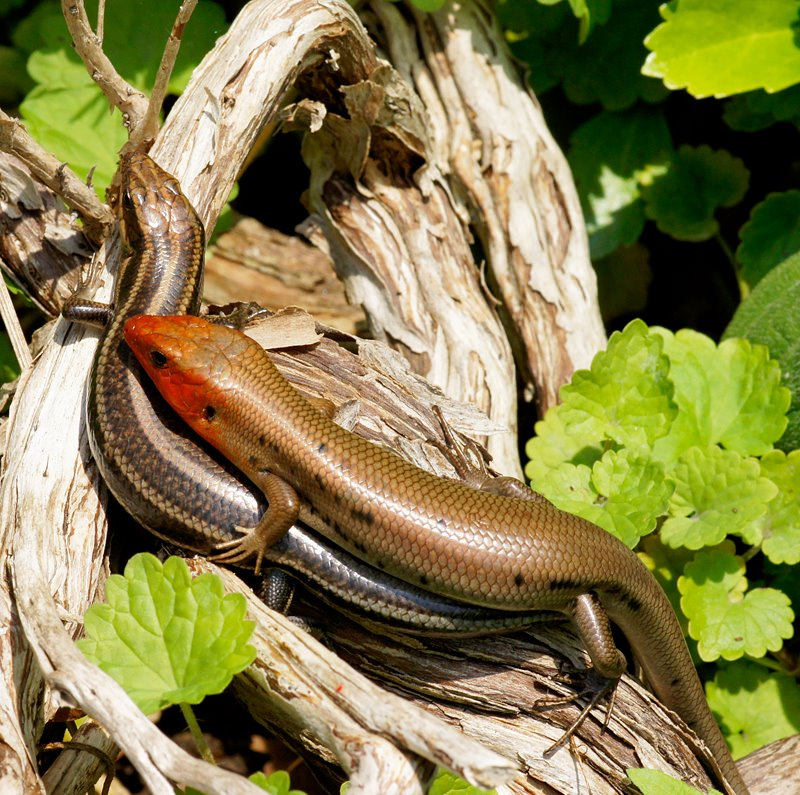

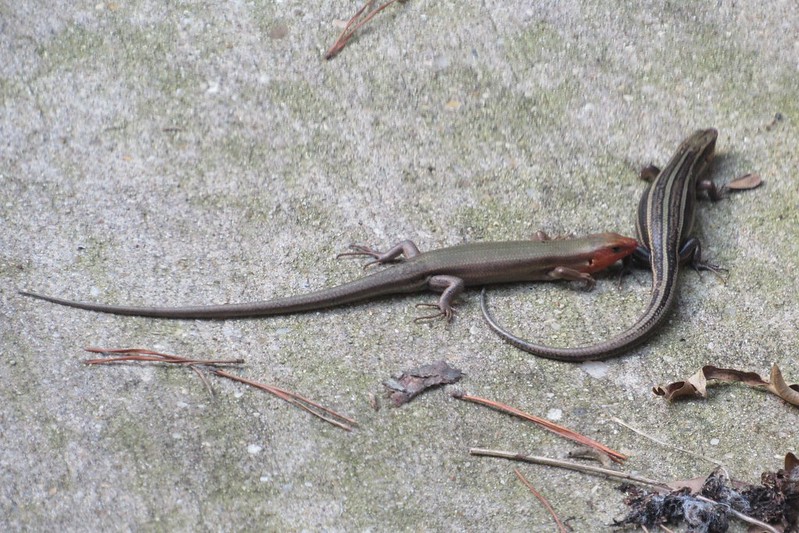
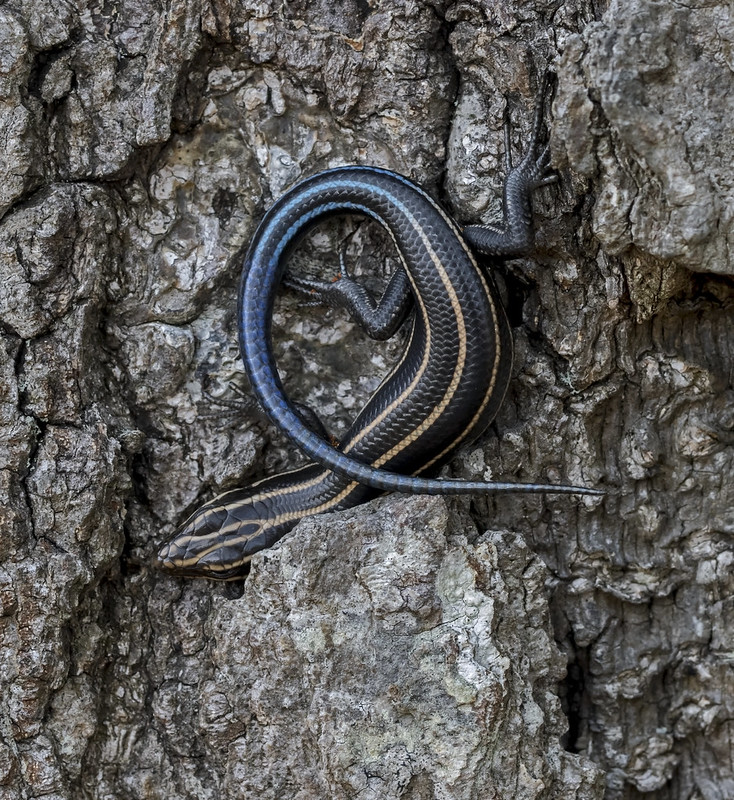
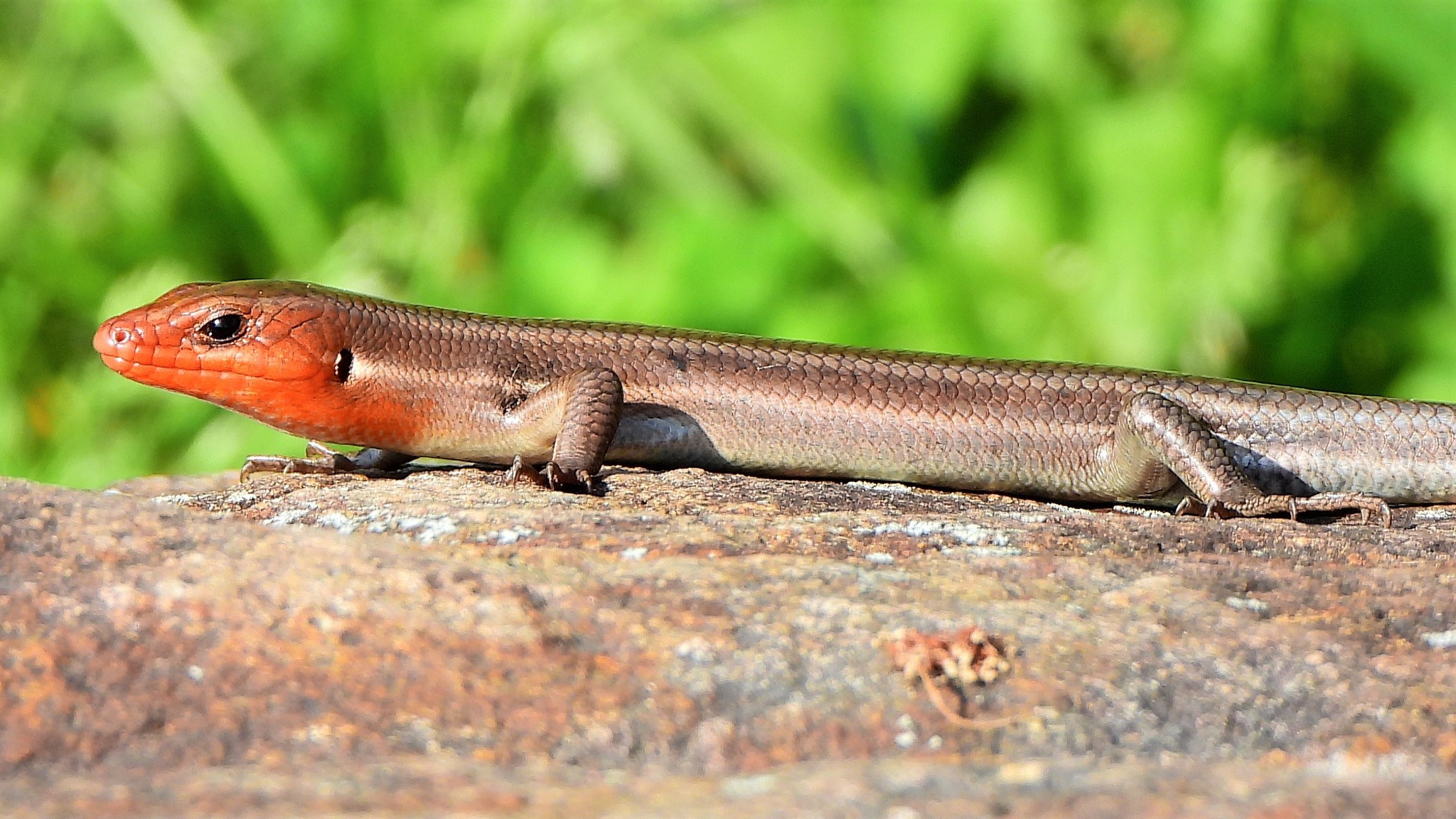

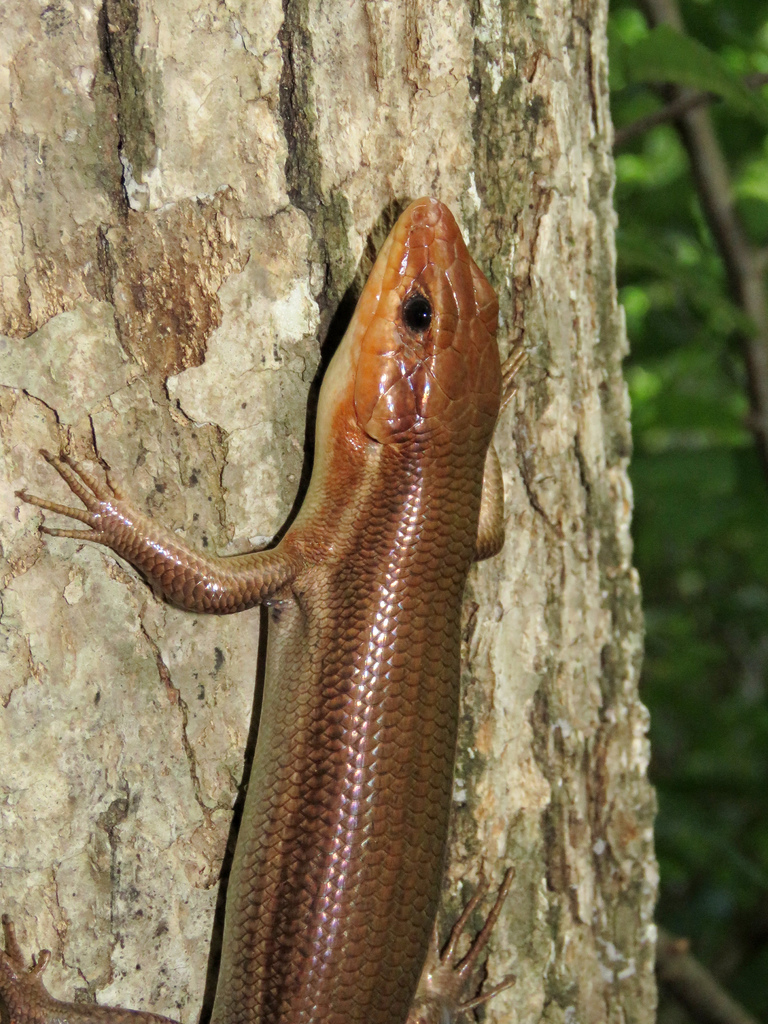
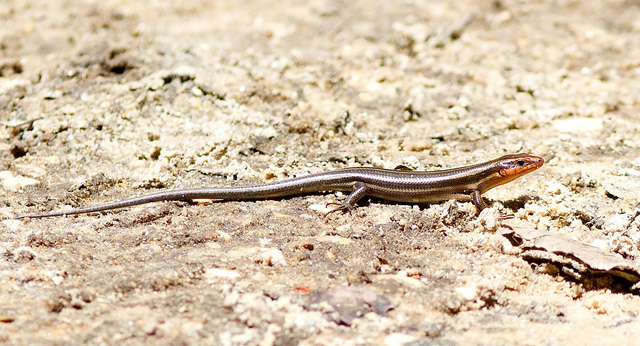
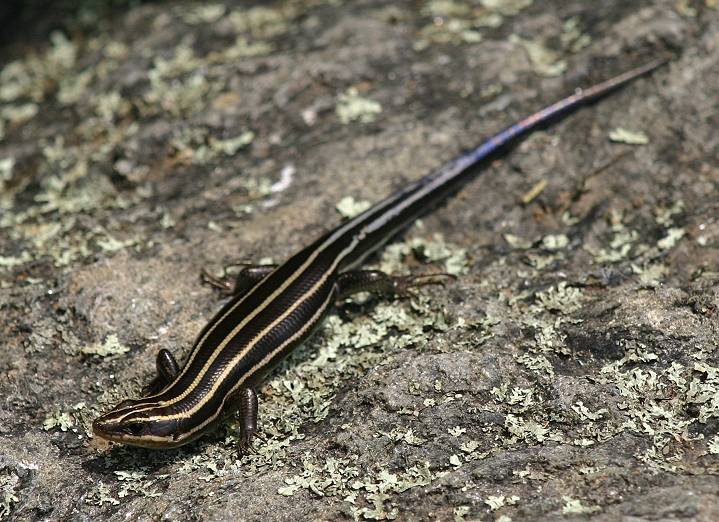
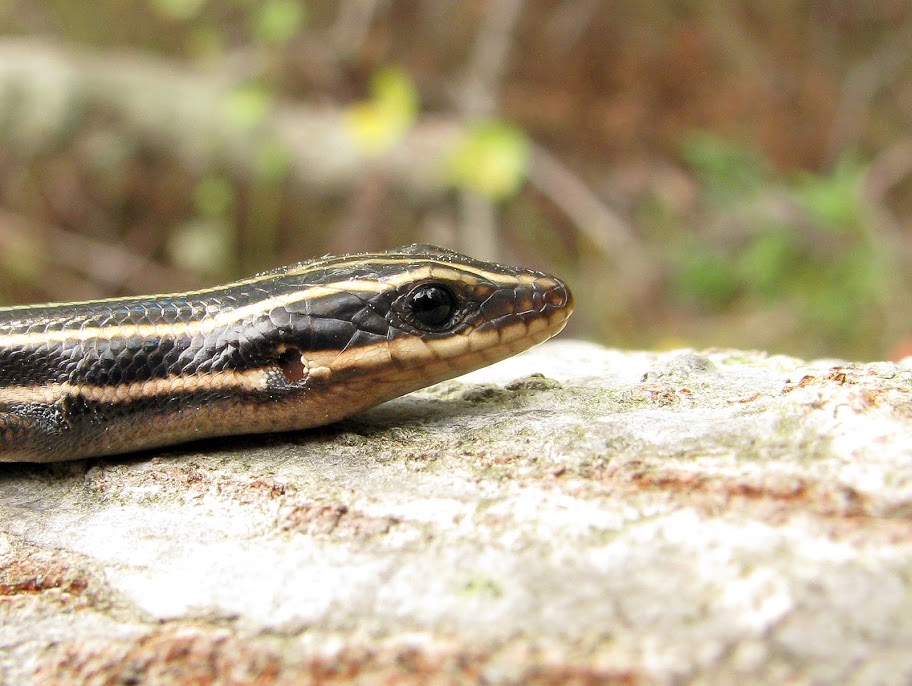
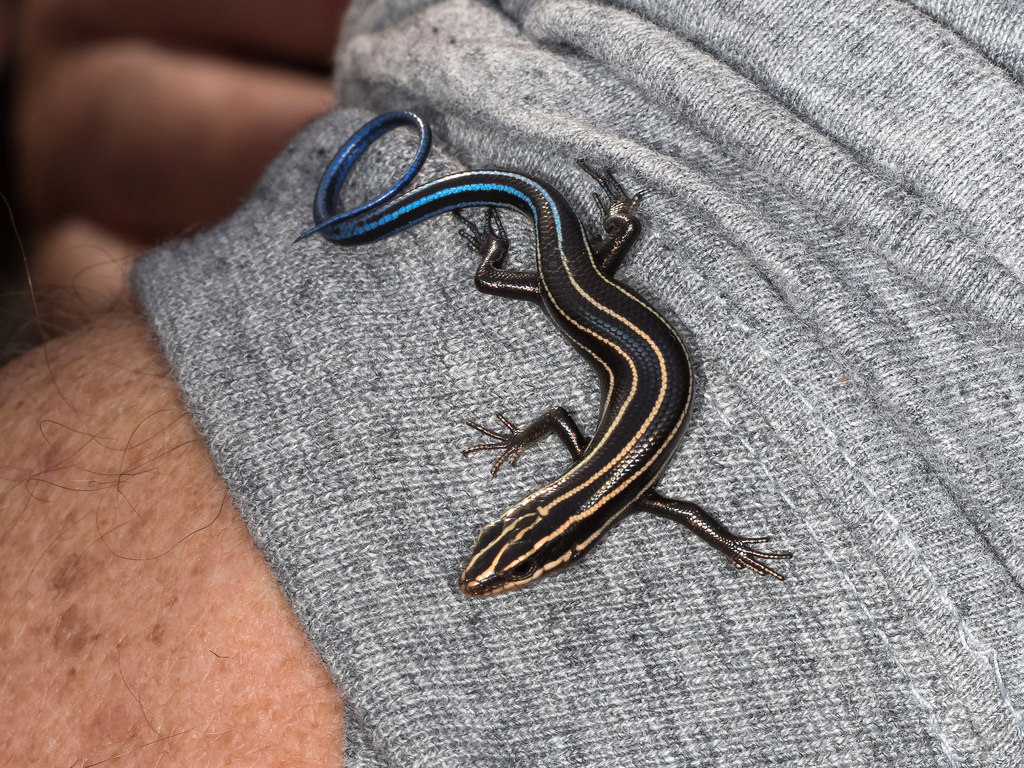


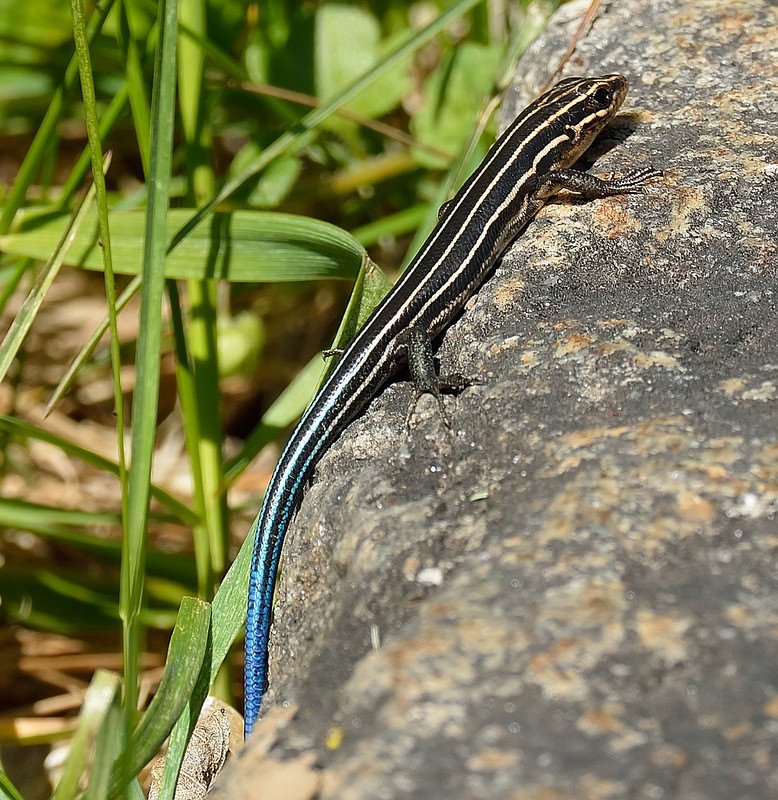
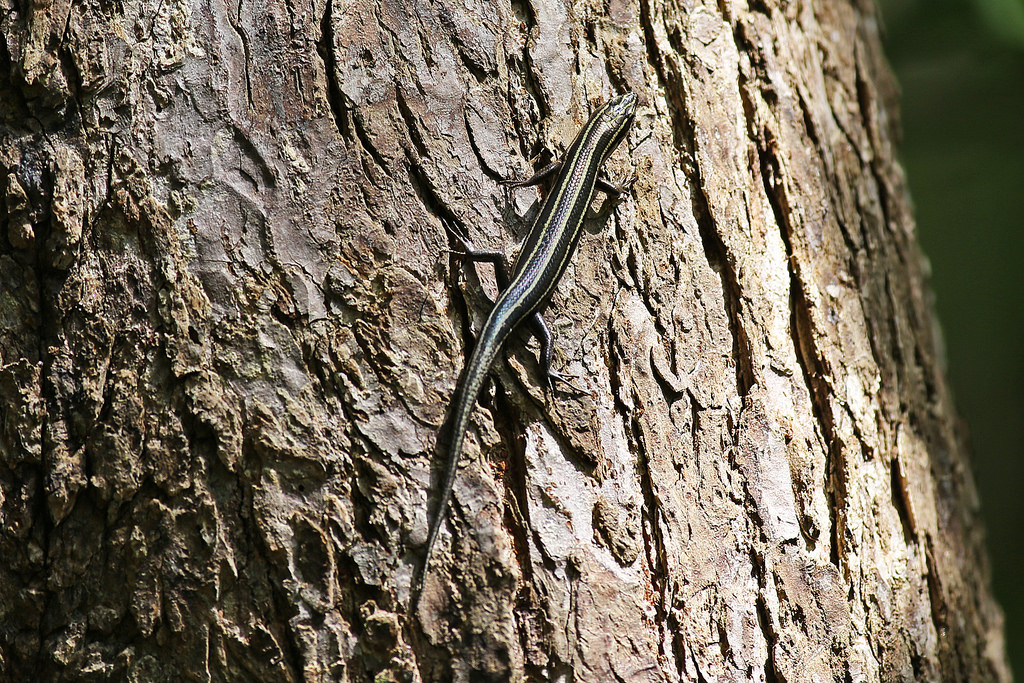
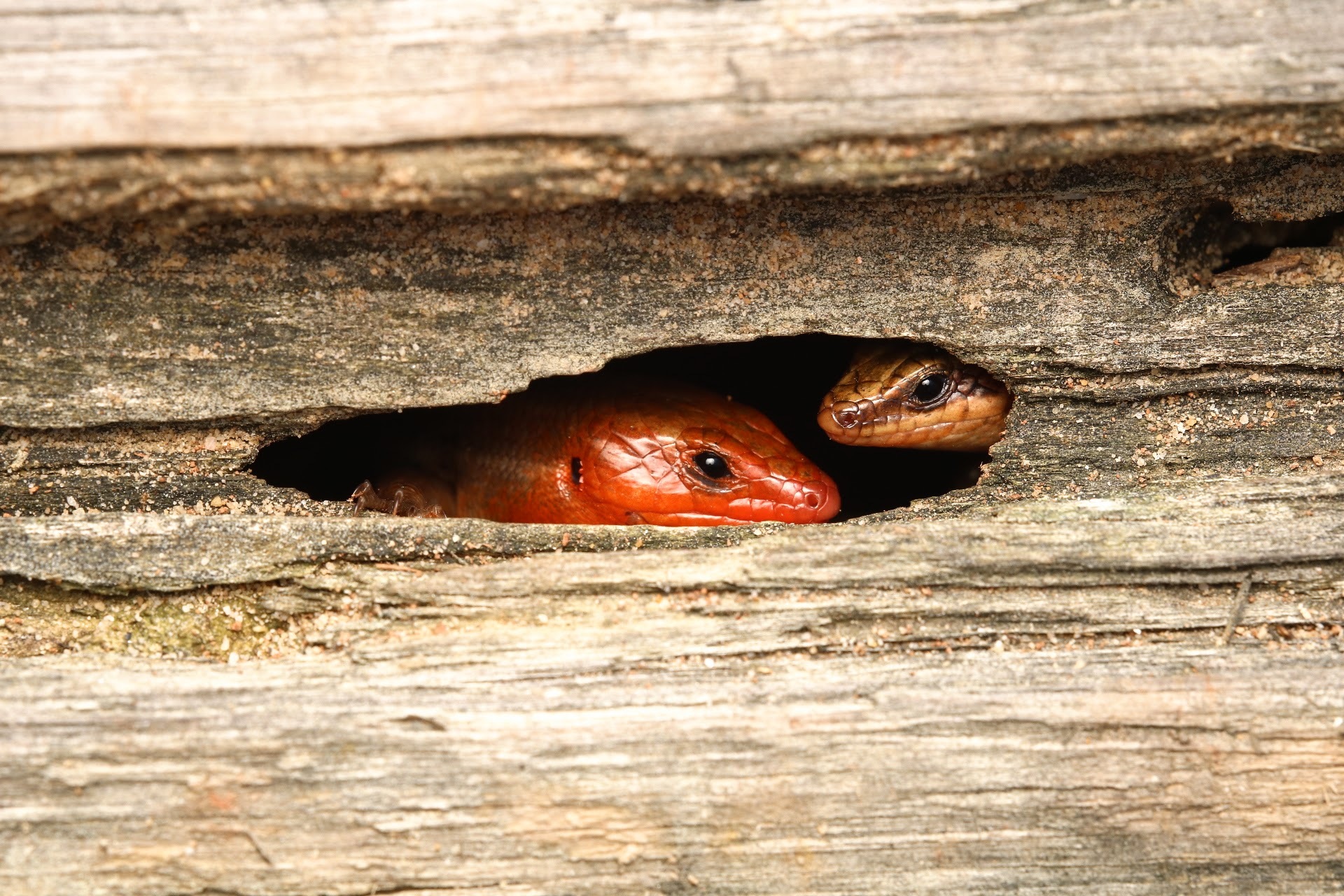
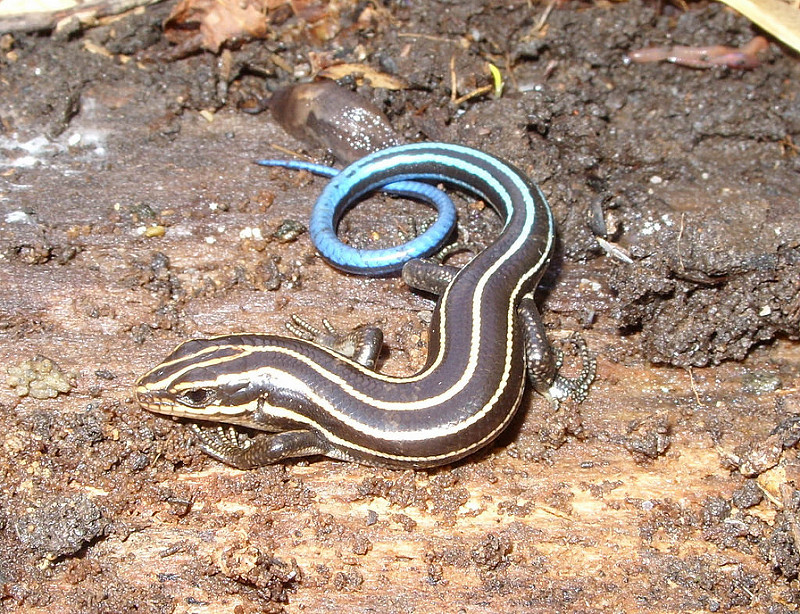
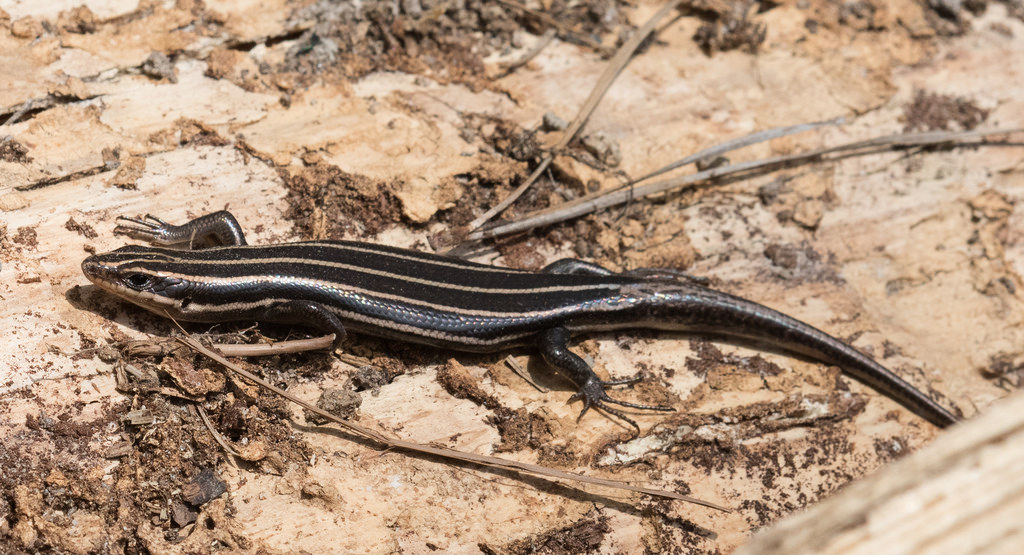
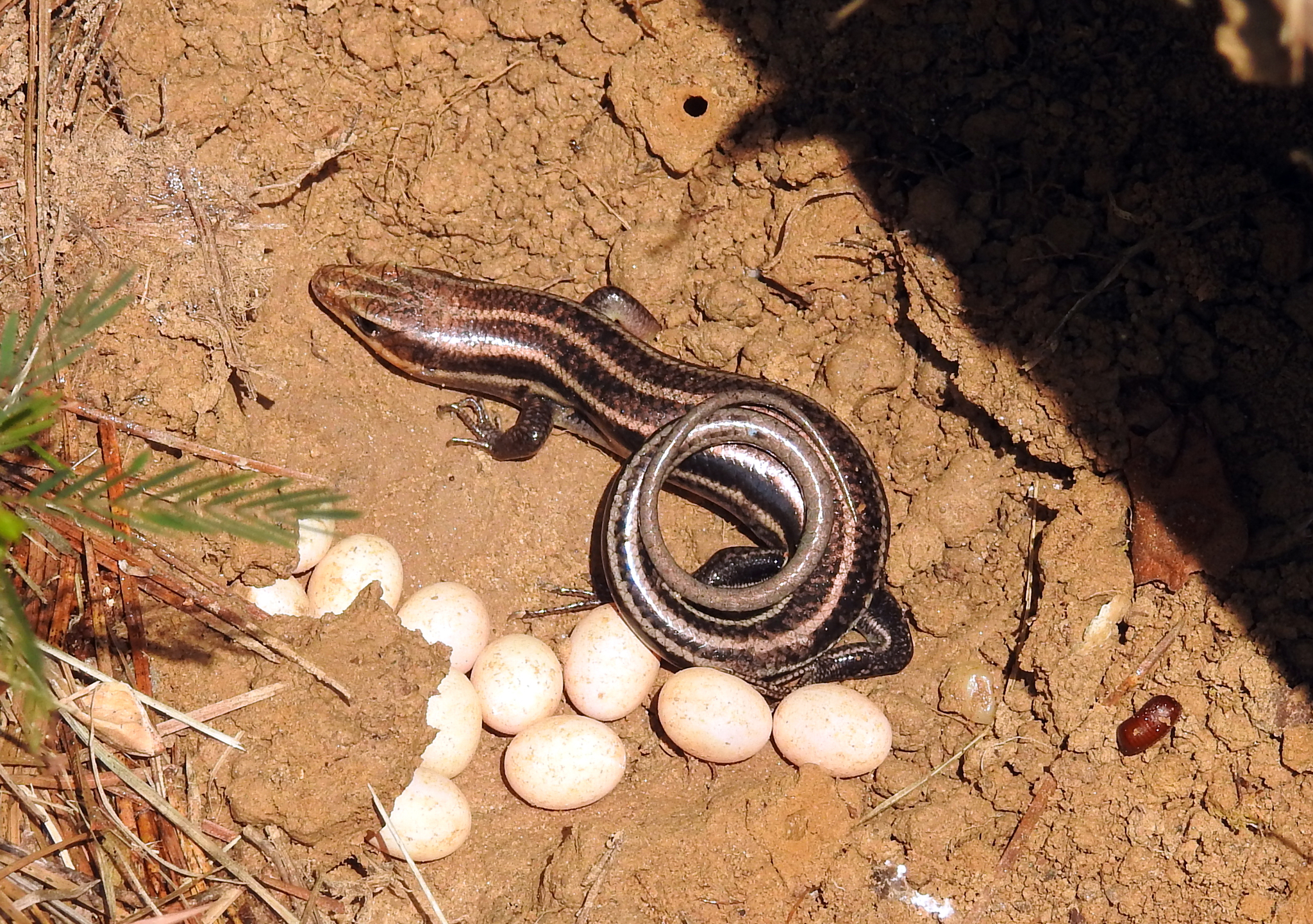
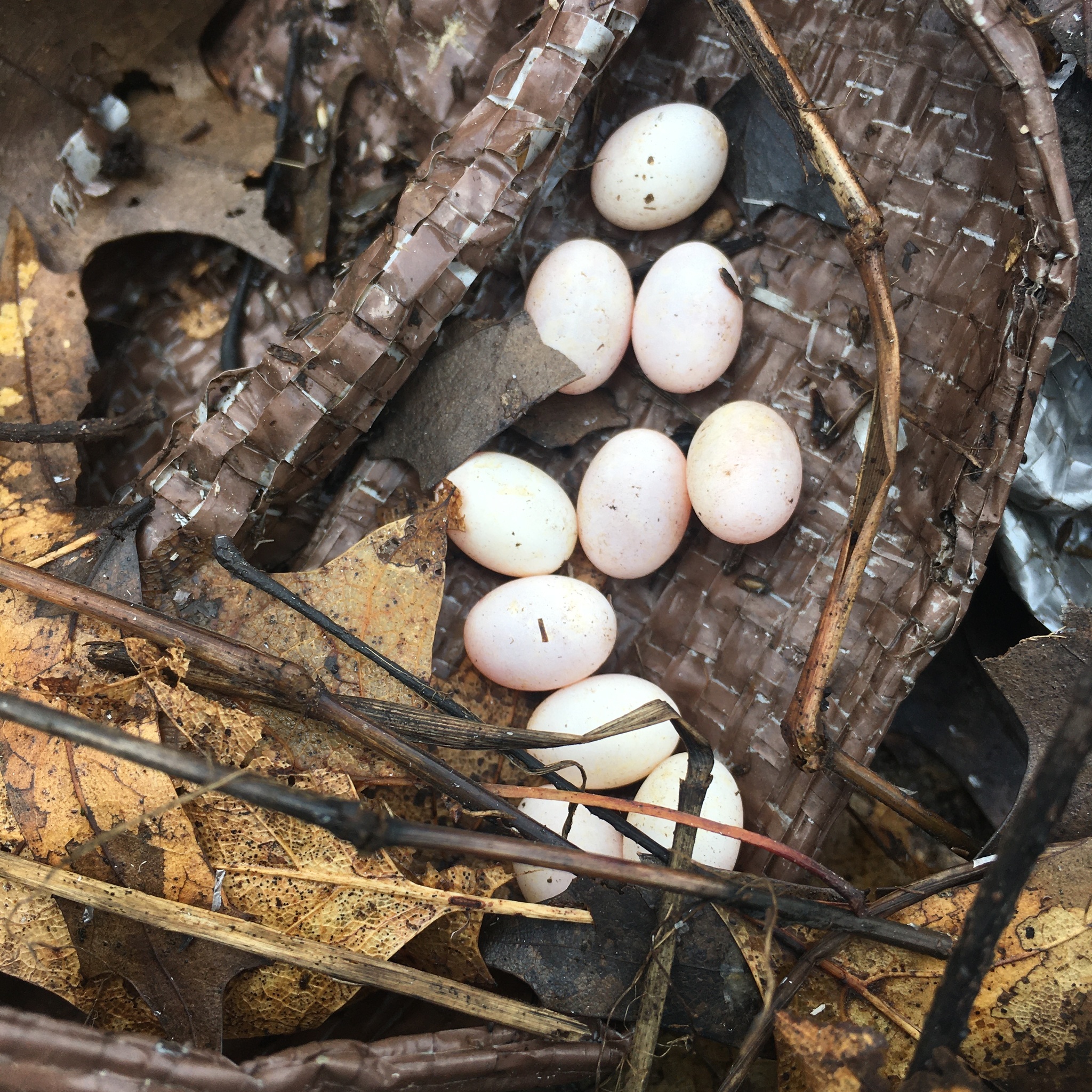
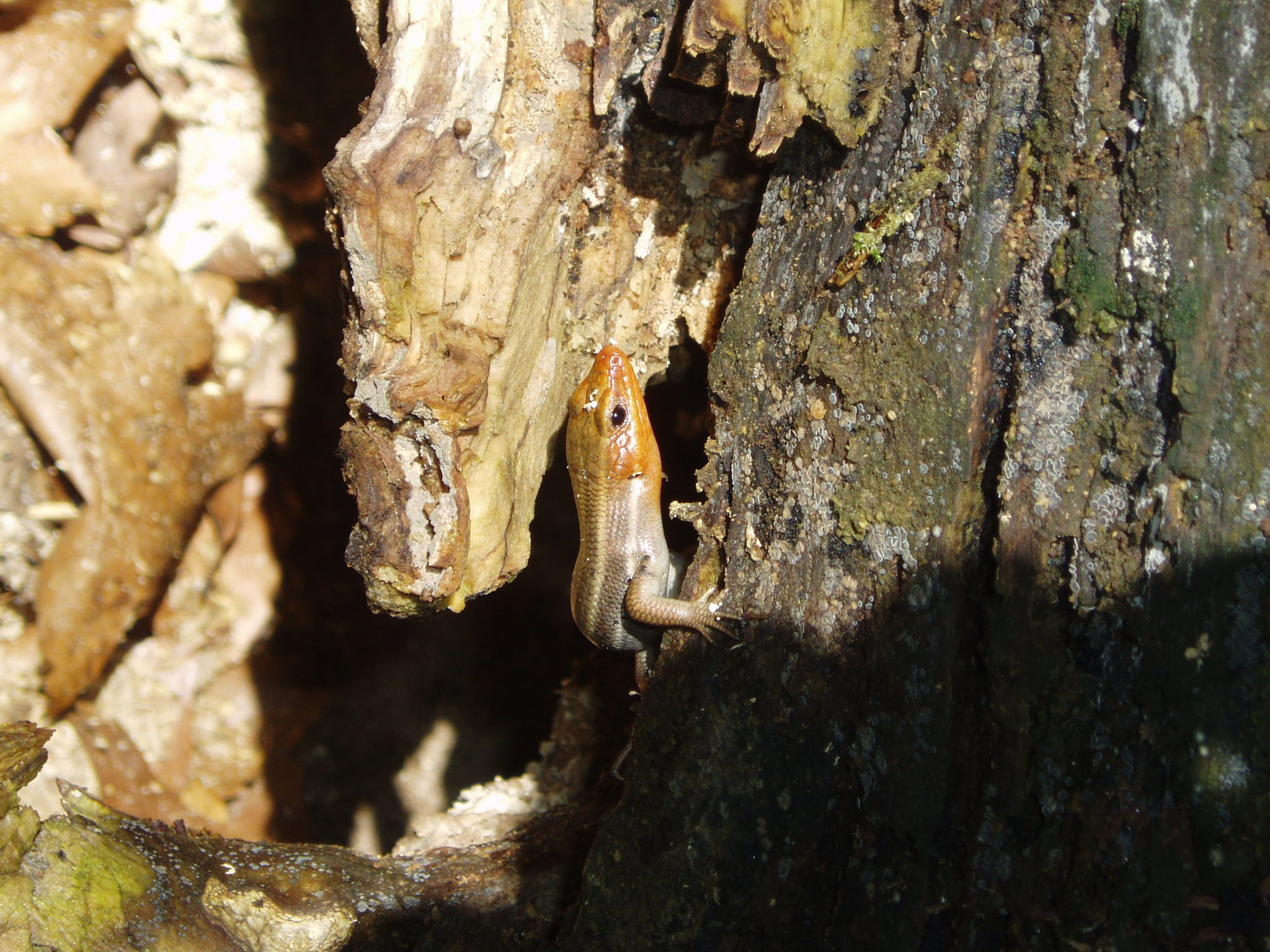
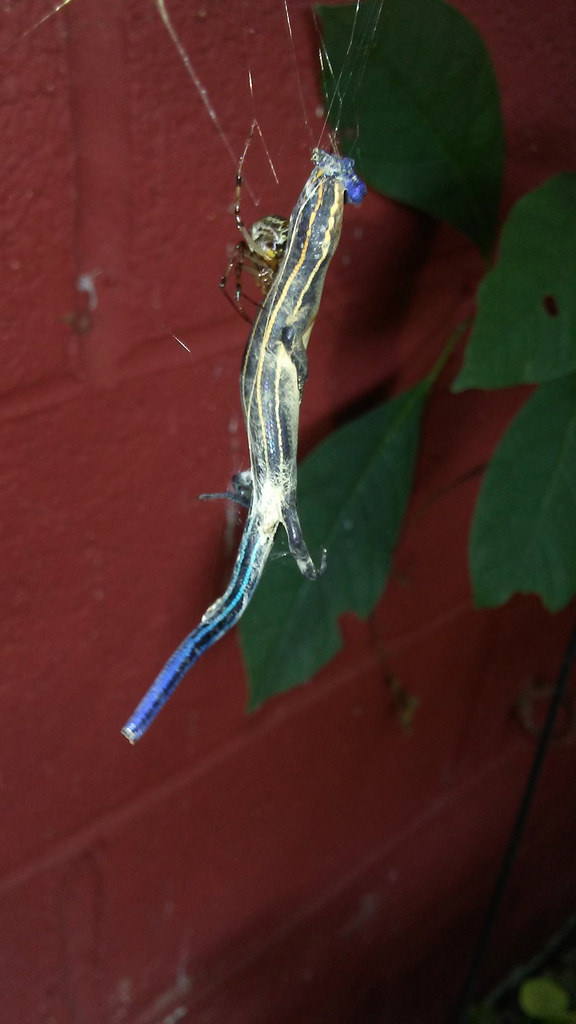




![Head, showing two enlarged postlabial scales, diagnostic for this species compared to P. laticeps[34][35]](http://upload.wikimedia.org/wikipedia/commons/thumb/e/ed/Eumeces_fasciatusPCCA20060326-2806A.jpg/120px-Eumeces_fasciatusPCCA20060326-2806A.jpg)


